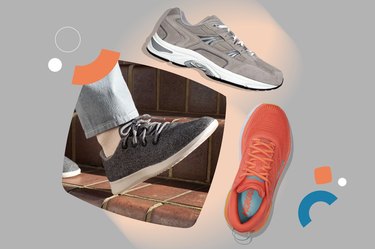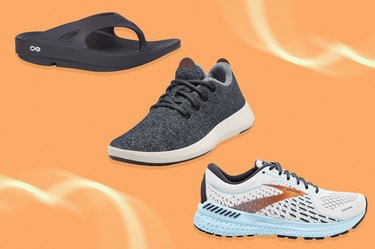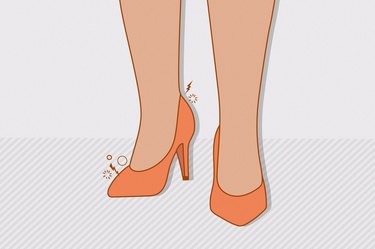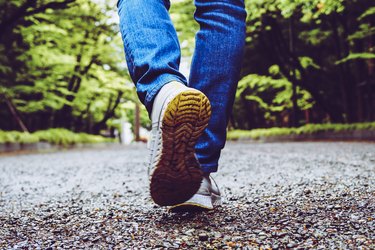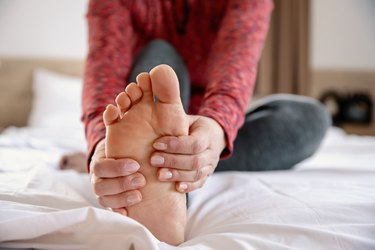
Toe spacers might seem like a quirky trend, but they're making big waves in the world of foot health. Whether you've seen them on social media (they look kind of similar to the foam toe separators you may use during a pedicure) or heard a friend rave about them, you might be wondering: Do toe spacers work?
The short answer is: Maybe, but they're not magic. Still, the benefits of toe spacers go beyond stretching your toes, and for people with certain foot conditions, they might be worth a shot.
Video of the Day
Video of the Day
Ahead, we break down what toe spacers can (and can't) do for your feet.
What Are Toe Spacers?
Toe spacers, also known as toe separators, are small devices (usually made of silicone or foam) that fit between your lower digits to spread them apart.
Their goal? To counteract the cramped positions your toes endure in closed-toe shoes, says Nelya Lobkova, DPM, board-certified podiatrist and founder of Step Up Footcare in New York City. Some are even designed to be worn inside those shoes (more on that later).
6 Benefits of Toe Spacers
Toe spacers might seem like a silly gadget, but their benefits for alignment, flexibility and overall foot health can make a big difference — both in your daily life and for your fitness goals.
1. Realign Toe Structure (Temporarily)
Toe spacers help straighten the big toe by gently pushing it away from the second toe, stretching the adductor tendon and promoting better alignment, Dr. Lobkova says. According to Dr. Lobkova, this is especially beneficial for conditions like:
- Bunions: Bony bumps at the base of the big toe can feel more stable and less painful with spacers temporarily realigning the joint. That's why we've included them in our list of the best bunion correctors.
- Hammer toes: These muscle imbalances cause toe contractures (when a toe becomes permanently bent or curled), which spacers can help straighten temporarily. (Hammer toe exercises may help, too.)
While toe spacers won't permanently fix bunions or hammer toes (they only help with alignment while you're wearing them), they can slow their progression and offer much-needed symptom relief, Dr. Lobkova says.
2. Improve Toe Flexibility
By stretching the tiny muscles inside your feet (intrinsic foot muscles), toe spacers prevent muscle imbalances and toe contractures, Dr. Lobkova says.
These muscles are tricky to target otherwise because they attach only to bones in the feet, making spacers a simple but effective stretching tool, she says.
It's worth noting here that wearing toe spacers may not prevent foot problems like bunions or hammer toes altogether. Things like your genetics, hormone shifts and medical conditions can all contribute to these types of foot issues.
3. May Relieve Toe and Foot Pain
Toe spacers can help ease various types of foot pain, according to Dr. Lobkova:
- Ball-of-foot pain: They can help with neuromas (nerve compression causing numbness and pain in the ball of your foot) by decompressing the nerve root.
- Corns: They can reduce rubbing and pain associated with corns (i.e., thick, hardened layers of skin that develop due to repeated friction and pressure between the toes).
4. Can Reduce the Risk of Foot Injury
Strong, flexible feet are less prone to injury. Toe spacers stretch the intrinsic foot muscles, preventing problems with the plantar fascia (the tissue that supports your arch), Dr. Lobkova says. This is particularly helpful for those with tight arches or calves — an all-too-common issue thanks to all the time many of us spend sitting at a desk all day.
5. Might Boost Gym Performance
Believe it or not, your toes play a major role in movements like squats. Proper toe alignment helps engage your foot's smaller muscles, improving form and reducing the risk of knee or back injuries, Dr. Lobkova says.
While she doesn't recommend squatting with toe spacers on, using them during rest or casual walking can prep your feet for better alignment during workouts.
6. May Help Improve Balance
If you've got foot issues like bunions, your balance might suffer. That's because bunions affect proprioception (your body's ability to sense its own position and movements) and balance, Dr. Lobkova says. By realigning the big toe and correcting deformities, toe spacers can help restore stability.
Balance becomes even more critical as you age — especially considering 1 in 4 older adults falls every year, with falls being the leading cause of injury and death among people ages 65 and older, per the Centers for Disease Control and Prevention.
Toe Spacer Risks
Toe spacers have plenty of benefits, but they're not without risks. Dr. Lobkova highlights a few things to watch out for:
- Soreness: Wearing toe spacers for too long can make your feet ache.
- Skin irritation: Adhesives on some spacers can cause abrasions or irritation, especially if they're not replaced daily.
- Not safe for everyone: People with peripheral neuropathy should steer clear. Reduced sensation in the feet could lead to unnoticed issues like blisters or wounds, which could lead to infection.
How to Wear Toe Spacers Safely
Ready to give toe spacers a try? Follow these tips to maximize their benefits while staying safe, per Dr. Lobkova:
- Choose soft materials: Opt for silicone, foam or neoprene spacers to avoid rubbing and skin irritation. Skip hard plastic applicators.
- Start slowly: Begin wearing them 20 to 30 minutes a day and gradually increase by 30-minute intervals as your feet adjust.
- Go barefoot: Kick back and relax with spacers on while watching TV or scrolling your phone.
- Be mindful with shoes: While some spacers can fit in shoes, they may feel bulky, especially in tight or pointy-toe footwear. Avoid wearing them in shoes that could cramp your toes, cut off circulation or cause blisters.
Dr. Lobkova’s Top Picks:
- NatraCure Gel Toe Spacers ($14.99, Amazon): Latex-free and designed for single-toe separation, these spacers release skin-friendly ingredients like aloe vera and vitamin E.
- VIVEsole Toe Separators ($9.99, Amazon): Made of medical-grade silicone gel, these are soft and even coolable in the freezer for anti-inflammatory benefits — though they may feel bulky at first.
- Welnove Foam Toe Separators ($13.99, Amazon): Lightweight and hypoallergenic, these foam spacers work well in most shoe types and are ideal for soft corns caused by bunions or hammer toes.
Alternatives to Toe Spacers
Not sold on spacers? There are other ways to stretch and strengthen your feet:
1. Resistance Band Stretch
This is a simple but effective way to work your big toes. Here's how to do it, per Dr. Lobkova.
- Stand with feet hip-width apart.
- Loop a resistance band around both big toes and perform heel lifts by slowly lifting and lowering your heels repeatedly. Try Serious Steel's 12-inch resistance band ($8.95, Amazon).
- Aim for 3 sets of 12 heel lifts daily.
2. Kinesiology Tape Stretch
Dr. Lobkova recommends kinesio tape for bunion realignment and pain relief. Unlike spacers, kinesio tape stays on during workouts, fits with all shoes and doesn't irritate the skin. Here's how to tape your bunion:
- Cut a 1-inch-wide strip from the big toe to just above the heel.
- Cut a 2-inch-wide strip to wrap around the foot, just below the toes.
- Anchor the first strip to the side of the big toe, applying it along the foot's side.
- Use the second strip to wrap over the bunion and around the foot with slight tension, leaving the ends flat. Rub to activate the adhesive.
You'll need: Kinesio Tex Gold tape, 1-inch ($14.95, Amazon) and Kinesio Tex Classic tape, 2-inch ($9.40, Amazon).
The Bottom Line
Toe spacers can be a handy tool for foot health, improving alignment, flexibility and balance. However, they're not a cure-all. Toe spacers won't be the magic bullet some people hope for, but they can make a real difference when used correctly.
Was this article helpful?
150 Characters Max
0/150
Thank you for sharing!
Thank you for your feedback!
Is this an emergency? If you are experiencing serious medical symptoms, please see the National Library of Medicine’s list of signs you need emergency medical attention or call 911.

